Amano, Baxter, Clarke, Dunne, Sinclair, & Slakk Consulting
Professional learning & consulting for all educators who serve multilingual learners & their classmates.
Professional learning & consulting for all educators who serve multilingual learners & their classmates.
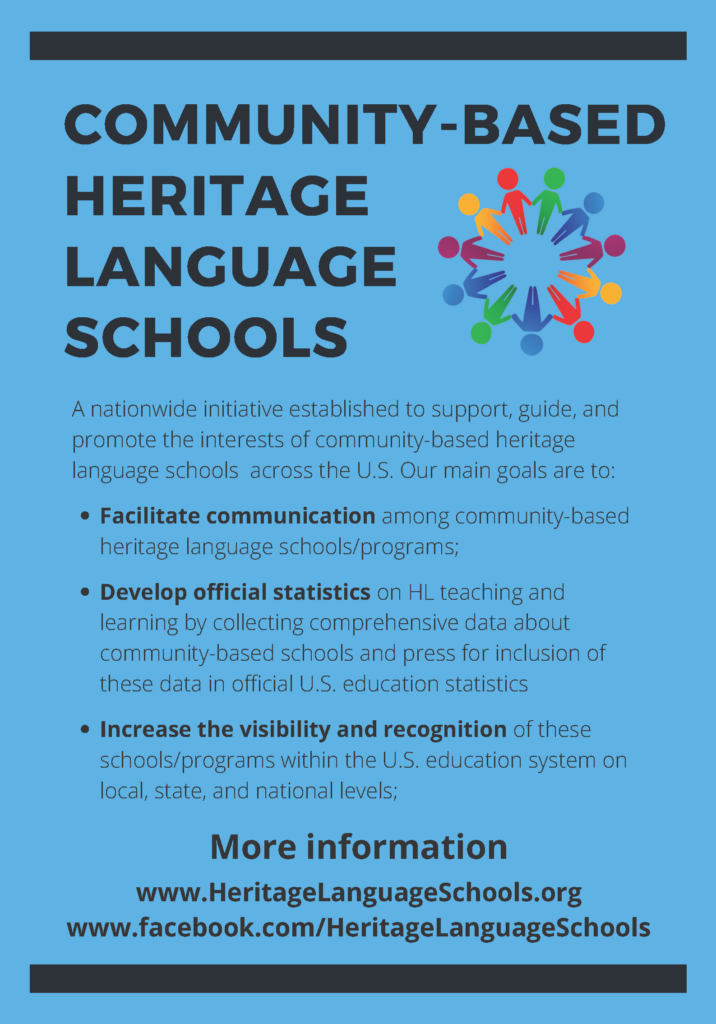
Facebook: https://www.facebook.com/HeritageLanguageSchools
There are thousands of community-based heritage language schools across the United States, teaching hundreds of languages. Joshua Fishman identified 1,855 schools in the 1960s and 6,533 in the 1980s (Fishman, 1966, 1985, 2001). The Coalition, established in 2012, seeks to connect, support, and advocate for these schools and build their visibility as a significant part of the national language learning landscape.
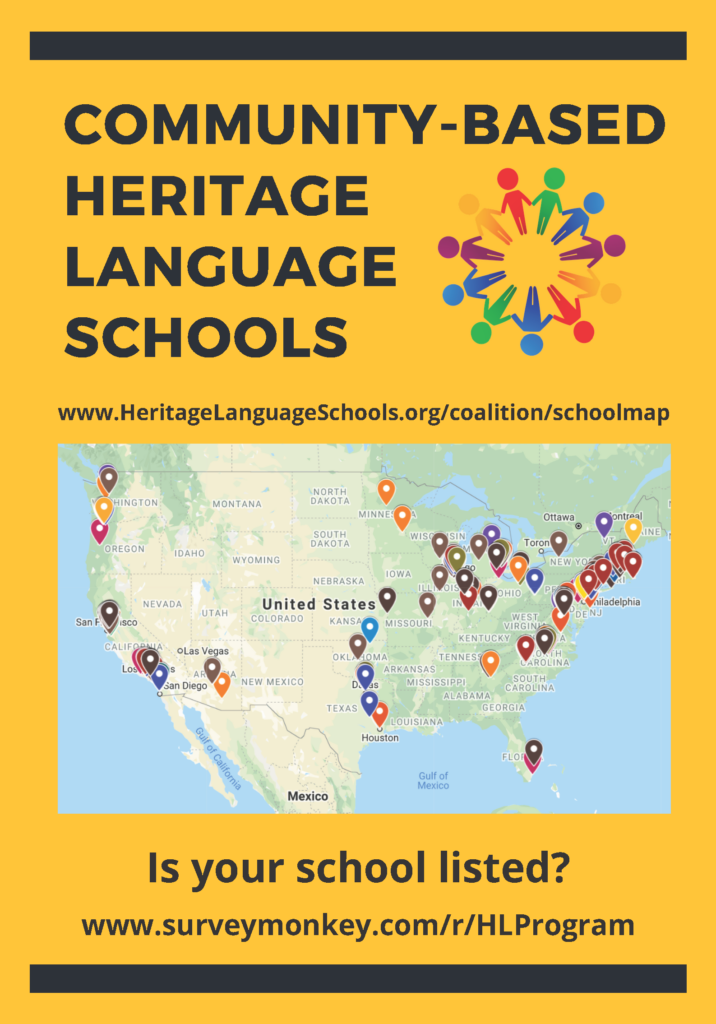
The Coalition does the following:
Collaborates with a group of Language Representatives, who represent the languages taught in community-based schools, are often teachers and administrators in these schools, and connect with their language communities and engage them in Coalition activities.
Documents community-based schools across the United States. Our goal is to document the thousands of schools teaching hundreds of languages that Joshua Fishman described. We have a long way to go!! If you know of schools, please ask them to complete the school survey. Here you can see a map of the schools documented at this point.
Hold an annual conference, which brings together school representatives across the country for panel discussions and workshops. The next conference will be held online Friday and Saturday, October 7 and 8, 2022, with an on-site component at American University in Washington, DC. Registration will begin in July. Please join us and let your heritage language colleagues know about it!
Plenary speakers:
Shuhan Wang, Ph.D.,
ELE Consulting international Chinese Language Education, Asia Society
Telling the Stories of Community-Based Language Schools in the United States
Felix Kronenberg, Ph.D.,
National LCTL Resource Center
Supporting Sustainable Less Commonly Taught Community-Based Language Programs
Kristin Davin, Ph.D.,
Professor, University of North Carolina – Charlotte
Motivating Students to Continue Language Development With the Seal of Biliteracy
Register now to attend the 10th Annual Heritage Language Schools Conference!
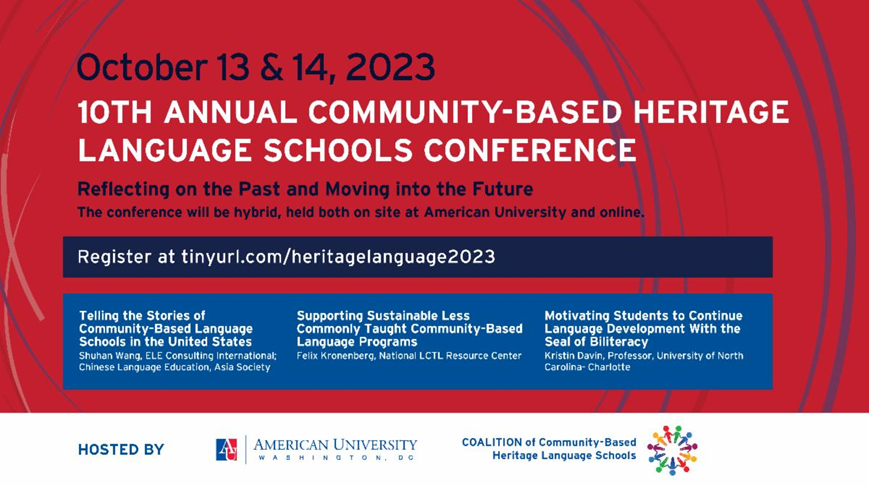
You can learn about and register for the conference and other activities by signing up for our newsletter. Newsletter (heritagelanguageschools.org)
If you would like to get involved in other ways, contact Joy Peyton, joy@peytons.us, Coalition President.
What’s in a name? In a word, everything.
When our students come to us, one of the most important things to do is to learn how to say their name and make sure that you call them by the name they wish to be called by. There are many great pieces out there on this topic, so I won’t linger. See below for several I felt were great.
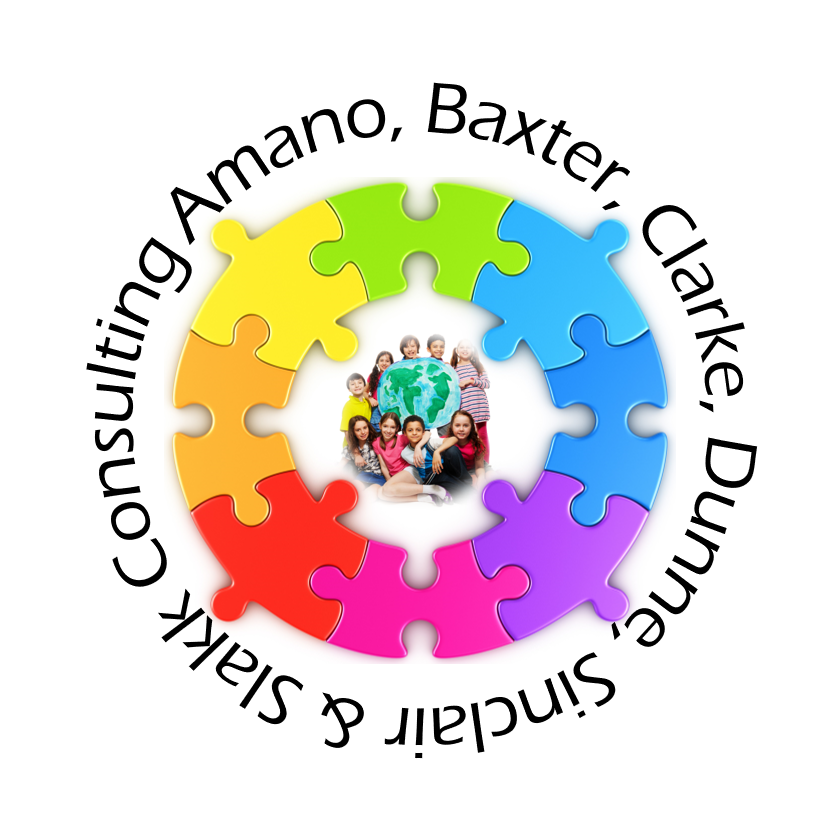
With that said, again, what’s in a name? For me it is almost everything. For that reason, our consortium is called Amano, Baxter, Clarke, Dunne, Sinclair and Slakk because these are the family and so very near to being family that have encouraged me and made sacrifices so that I, Shawn, could be the first to attend college and even be doing what I am doing now. Without their support, it wouldn’t have happened. So, thanks to Koichi, Sachiyo, and grandma Yoshi (a.k.a. Obachan) for “adopting” me and my family and encouraging me to pursue my dreams. We miss you Yoshi and Koichi. Thanks to great grandpa Harry A Baxter, great-great grandpa George Washington Clarke (who allegedly had the first casino in the Pacific Northwest), great-great grandma Maggie Dunne, grandma Lois Sinclair and great grandma Irene from whom I have taken my last name of Slakk.
I founded the group with the word “consortium” in mind since I can’t do it all. My colleagues and I do have a vast cadre of talents and years of experience working with all levels and needs for teachers and learners. We cover all contents and grade levels. We work with teachers who teach and work with bilingual learners, students with disabilities, core-content, literacy, and even adult English learners and workplace literacy. We enjoy assisting educational professionals to increase their professional and pedagogical content knowledge Over the next few weeks and months, we’ll rollout introductions to those who will be working with me as a team to provide whatever professional learning services you as an educator may need to serve the learners you teach. Please feel free to reach out (shawn@abcd2sco.com) and ask if you don’t see something on our website. If you are a professional learning coordinator or a principal and are looking for PD or professional learning services, just ask. We’ll do our best to accommodate, tailor and refine our sessions so that you, the teachers, and the kids are more successful.
Thanks for all you do for the kids.
Shawn
The beginning of the year is always a great time to set the tone of the class and your relationship with your students and their family. Before they all arrive, learn a bit about them and share a bit about yourself. The end of the year is the best time to start thinking about the next year.
Make the First Move and Introduce Yourself
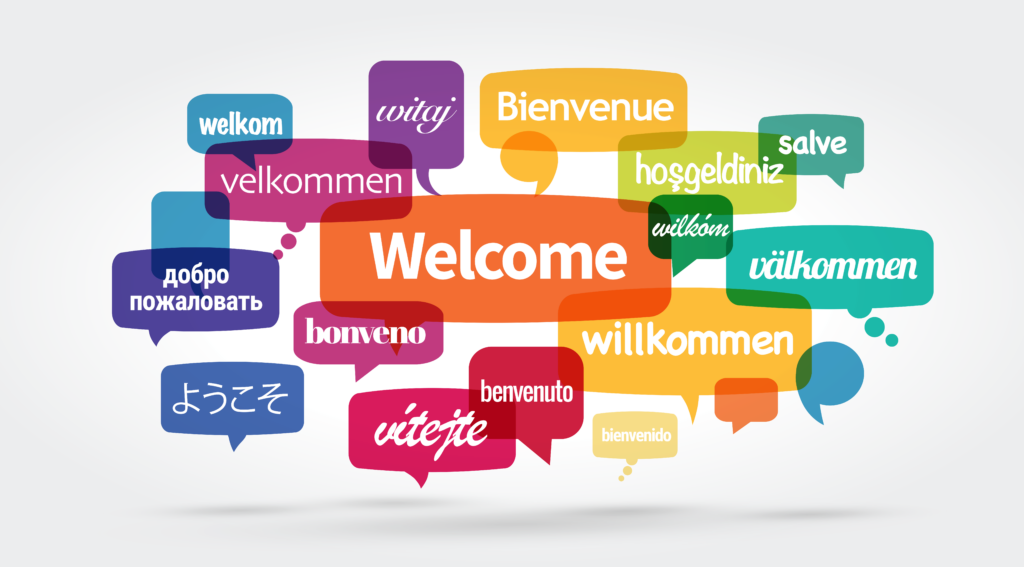
For your class website record a short intro video introducing yourself. Add a few things like what you like to do with spare time or whatever you are comfortable sharing. It doesn’t have to be long. Do it in as many languages as you can. If possible have the video dubbed or translated into the languages that you don’t know but your students’ parents speak. Include your contact information like school phone number or your email. In lieu of that or better yet, in addition, call the family before the first day of school. Don’t worry if you don’t speak the parents’ language, they will get the idea that you are trying to connect and build a relationship with them; that you see that their son or daughter is important.
Get to Know Your Students Before They Arrive
Know who your students are before they arrive. Gathering information beyond the basics before they arrive makes them visible to you as an individual. If they are emergent bilinguals or part of a dual language program, double check their language development levels in the base domains of reading, writing, speaking, and listening—in both languages. How long have they been in U.S. schools? What other languages might they speak? How many years of schooling do they have? How many different schools have they been in since they started school and where? What development level is Javier at for reading? Writing? Is it the same in English and Spanish? How long has Olga been in U.S. schools? Does she also communicate in another language beside the target languages at school? How often does Francisco change schools or go back to Ecuador? The rest of the information you can find out from the student when you talk with them the first few days of school, or when you talk with the parents or previous teachers.
Write it Down in One Central Location
Much of this information should be available in the student’s cumulative folder which you will be reviewing anyway. While reviewing those folders, take notes. When talking with the parents assure them that you are only wanting to learn about their child to help him or her be successful. It may take a while at times for the family to open up to you, but persistence and respect will yield good information. Along those lines, I remember that it took more than two years to get the whole story behind my student Vasili. Don’t give up.
To organize this info into one place when I taught, I always preferred a spreadsheet. Spreadsheets are easy to edit and revise. Today’s software is even more functional now and some have such great connectivity that you can even electronically collect evidence of growth and link it to the sheets. But I digress. Every time a new student arrived, I added them to my chart. Each quarter I reviewed where each student was in each of the domains.
Plan Groupings for Different Activities

After collecting this information, think about your classroom setup. Groups of four works well and facilitate partner work and other small groups for cooperative learning. In these teams of four make sure to consider ELD level and domain framework levels. When possible group native speakers with the multilingual learners. A good rule of thumb is one native speaker, one or two high level emergent bilingual and one low level bilingual. When a Newcomer arrives, add the Newcomer to a quartet for support until they are ready to be on their own. Groups of six is too many and should be divided into trios. Depending upon the activity and the students’ needs, these groups are very adaptable. In dual language programs, groups will change based upon the target language and instruction. Use your data and information you are collecting in your chart to rearrange for each student’s strengths.
Plan for Revision and Review
In your calendar, make a date with yourself at least once every nine weeks to review what you know about each student. Don’t just pencil it in, put it in ink and don’t postpone. At these checkpoints, ask yourself as few questions. How far has Javi grown in reading? What else do I need to know about Olga? What success can I share with him or her and his or her family? What goals have they reached that I need to reset? When was the last time I checked in with Paco? Whose family haven’t I called home and introduced myself to? The year goes by so fast with curriculum, pacing guides, tests, and holidays before you know it, the year is gone and without firm commitment and reminder. Things go unreviewed.
Bonus and Most Important.
Plan, create, and practice balance. Go home at a reasonable time. Leave work at work. Enjoy evenings and weekends with friends and family. Make sure to decompress and recharge each day even if it is only for 5 minutes. Your social emotional health is imperative to a great and successful year.
Previously posted on duallanguageschools.org/school-talk (Slakk, 2019)
The America’s Languages Initiative for Equal Access: Promoting Systemic Change for Language Education in the U.S.
Language enrollments in the United States have seen little change in the past half century, remaining at approximately 20% in grades K-12 and 8% in higher education. One reason for these continually low percentages is the perception in this country that English is sufficient as the language not only for communication in this country but for international engagement as well. Another reason is our consistent failure to make language education truly accessible and relevant to all learners in this country who need and desire it, so they have access to jobs here and in other countries, health and legal services, and a sense of being world citizens. The future of language education depends on genuine systemic change, by dramatically increasing access to demonstrably effective instruction for all Americans in all of America’s languages.
“…a national strategy to improve access to as many languages as possible for people of every region, ethnicity, and socioeconomic background…”
America’s Languages, Executive Summary
The goal of this initiative is to promote, create, and sustain systemic change in the ways that language education is perceived and implemented in the United States, by demonstrating grassroots success in providing equal and equitable access to all of America’s languages for all learners. This includes individuals who often do not have access to schools and classes where these languages are offered — Black and People of Color; Native American, heritage, immigrant, and refugee populations; and people living in high-poverty rural and urban communities.
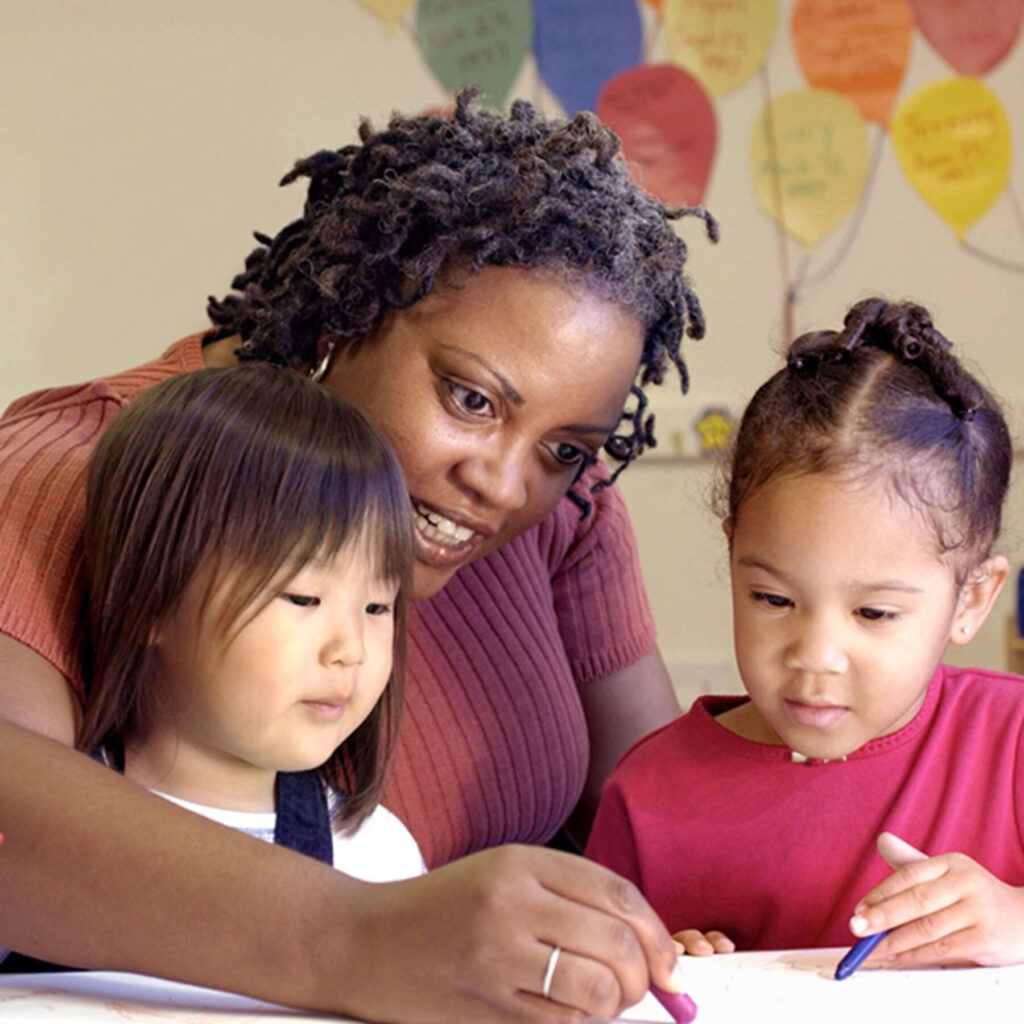
With the support of the Andrew W. Mellon Foundation, the Initiative has developed the pilot Guide to Exemplary Programs and Practices in U.S. Language Education, where programs are identified and described, to serve as models for teachers, administrators, and funders to meet the needs of these communities of learners. America’s Languages Working Group members and Fellows, recognized educators and stakeholders, volunteer their time to build and populate the guide. In the fall, 2021, the guide will be finalized, and school leaders can apply to be included as exemplary programs or nominate other schools.
Joy Peyton is a Working Group member.
To learn more about America’s Languages Initiative, visit: America’s Languages for All Learners.
Well, ok, relaunch. What a crazy ride revamping and reloading everything onto a different type of website format. I knew what I wanted to add and it took a bit of learning to do it. Still lots of work to do to fill in the placeholders I needed to add. So if you see something you would like more info about, email me. Otherwise, thanks for your patience while I retool and polish. It isn’t perfect and anyone who sees a typo or a broken link (yep there are many dead-end links I’m rerouting and adding to), PLEASE, email me shawn@abcd2sco.com. I’ll be very grateful.
Some new items include an implementation forum. We have public and private forums to help the community at large and our REAL Literacy trained implementers who work within their own private PLCs. The private areas will soon have forms, exemplar videos, and mini-refreshers available. If you’d like access to one of these PLCs as a member of that school or district, fill out the registration form, otherwise feel free to review the public forums and participate.
Additionally, we have refined and revamp our services. Check them out to see how we can work together to make teaching and learning easier and more successful.
We are also in the process of polishing our supports like our Language Support Menus (LMSs) and quality interaction activity directions and facilitators. The Linguistics 4 Multilingual & English Learners activities and examples section is being populated as well. Check it out and feel free to share your examples or ask for suggestions. If you share with us, we’ll give you full credit.
Two other new pieces will be a Friends & Partners section where we will highlight all those great post, resources, padlets, tweeters, and bloggers out there that we feel are the epitome of multilingual learning (coming soon). The other new piece will be book and article reviews that we feel contribute to the cause. We’d love to have a book sharing club forum, so speak up if you’d like to suggest titles or have ones you’d like to review (coming soon).
More later. Visit often. Email us and let us know how we are doing.
See you out there and kudos for all you do for your colleagues and learners.
Shawn & the Team.
Self-care is just as important as caring for your students or family. Take time to, as they say, “smell the roses.” From time to time the category Non Sequitur will pop up with some totally unrelated items to teaching other than to show that there is more to life than work. It may be recipes Shawn or a team member wants to share (food and or beverages), it may be pictures of hobbies, travel or pets. If you’d like to share, just email us below and make a suggestion.
This post’s photos are courtesy of Shawn.










If you’d like a copy of one of Shawn’s photos, email him at shawn@abcd2sco.com.